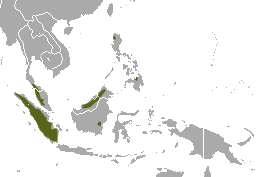Dayak fruit bat facts for kids
Quick facts for kids Dayak fruit bat |
|
|---|---|
| Conservation status | |
| Scientific classification | |
| Genus: |
Dyacopterus
|
| Species: |
spadiceus
|
 |
|
| Dayak fruit bat range | |
The Dayak fruit bat (Dyacopterus spadiceus) is a special type of large, fruit-eating bat. It lives only in parts of Southeast Asia, like the Malay Peninsula and the islands of Borneo and Sumatra.
This bat is quite rare. Scientists don't find many of them. This is partly because they don't often fly into the lower parts of the forest where nets are usually set up to catch bats. There are three known types of Dyacopterus bats. All of them live in the forests of Malaysia, Thailand, and the Philippines.
Contents
Where Dayak Fruit Bats Live
The Dayak fruit bat is very rare in places like Peninsular Malaysia and Borneo. It has not been found in Thailand. Scientists have caught these bats in a few spots on Borneo. These include Poring, Kubah, Kota Samarahan, and Pontianak.
Finding these bats in new areas like Kalimantan Barat, Indonesian Borneo, helps us learn more about where they live. These new discoveries show that the Dayak fruit bat's home range is larger than once thought. It extends to the western and southern parts of Borneo.
What Dayak Fruit Bats Look Like
The Dayak fruit bat is a small bat, weighing less than 150 grams (about the same as a small apple). Its fur is short. The bat is gray-brown on its back and silver-gray underneath.
It has a short tail. This tail is only about 10 to 20 percent of its body length. Its wing membranes connect to the second toe on each foot. The Dayak fruit bat is the smallest bat in its group, called Dyacopterus.
What Dayak Fruit Bats Eat
Dayak fruit bats are frugivorous. This means they love to eat fruit! They find their food from trees that grow very tall in the forests of Malaysia. Figs are a big part of their diet. They also eat other fruits that are ready to pick in the high parts of the forest.
These bats seem to prefer fruits from old, natural rainforests. This makes them sensitive to deforestation. When forests are cut down, it's harder for them to find food. Fruit-eating bats are very important for rainforests. They help spread seeds from fruits. This allows new trees to grow and keeps the forest healthy.
Bat Life and Habits
Scientists have caught a few Dayak fruit bats to study them. They found adult males and females. Some female bats caught in September were pregnant. These bats were found near fig trees in a swampy forest. Other females were found feeding their young in August and September.
Most of these bats were caught high up in the trees. Some were caught between 10 to 15 meters (33 to 49 feet) above the ground. One was even caught more than 30 meters (98 feet) high, above the main forest canopy. However, some were also found closer to the ground in swamp forests.
There isn't a lot of information about the daily lives of Dayak fruit bats. This is because they are rare and hard to study.
How Dayak Fruit Bats Reproduce
Since there are not many Dayak fruit bats to study, we don't know a lot about how they have babies. However, from what scientists have learned about other fruit bats in Malaysia, Dayak fruit bats seem to be monogamous. This means they likely have one partner. Both male and female bats can start having babies when they weigh about 70 grams. This is about half their adult weight.
We don't know exactly how long the mothers are pregnant. But pregnant females have been found from June to July. Females feeding their young have been found from June to September. This suggests that mothers feed their babies for one to two months. After that, the young bats probably leave the nest. Females have been found carrying one or two babies. In one study, a male and a pregnant female bat were found living together in a hollow part of a fig tree.
Special Male Bats
Interestingly, male Dayak fruit bats are known to produce milk. This is very unusual in mammals! Scientists are still trying to figure out why this happens. One idea is that it might help the female bat. If the male also helps feed the young, it could take some pressure off the mother. This might give these bats an advantage in surviving and raising their young.
See also
- Mammals of Borneo


